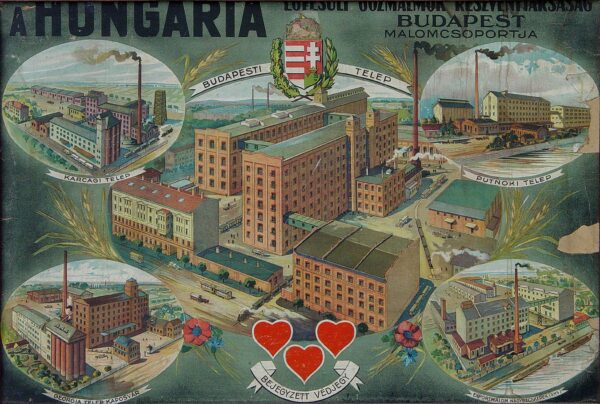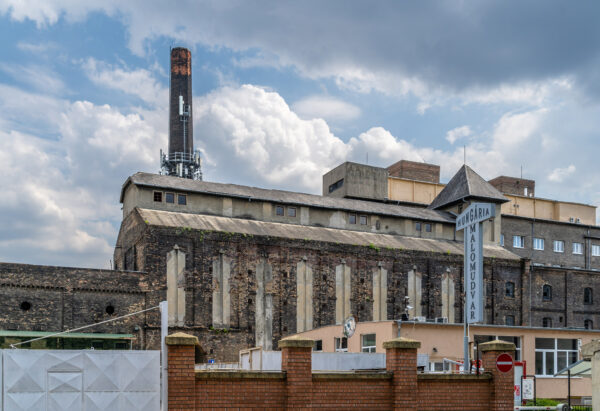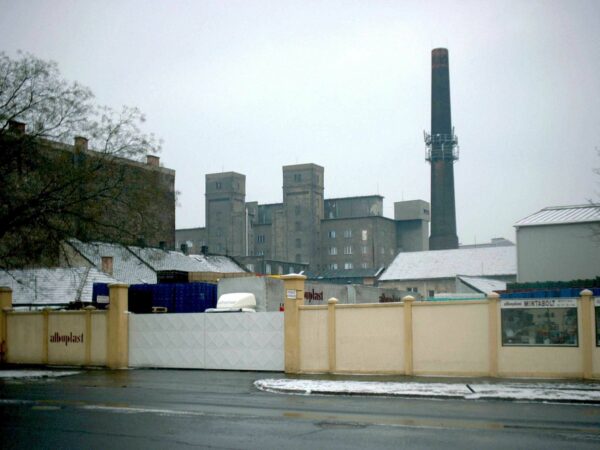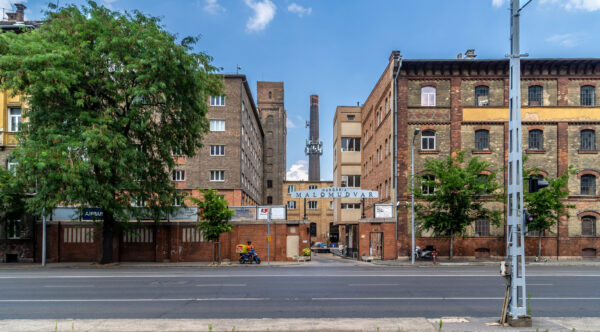Hungária united steam mills ltd

The history of the steam mills is intertwined with the history of the capital: although the steam mills were established before the unification of Buda, Pest and Óbuda in 1873, their development was influenced by the development of the economic role of the capital. In fact, the growth of the population led to a greater demand for foodstuffs, including cereals. The succession of steam mills had the advantage of being steam-driven, allowing them to be sited freely without the need for water or wind. In terms of transport, however, the proximity of the Danube was essential.
The so-called "high milling" method, which was widespread in Hungary, was as follows: the grain was first taken from the warehouse to the mill, where it was cleaned of major impurities and the husk in the milling machine. The task of the 'tarar' was to clean the wheat grain before it went to the wheat classifier, which was able to sift out the defective grains. The thresher was responsible for filtering out the kernels and the brushing machine for removing the dust. The last operation before milling was conditioning, during which water equivalent to 2-3% of the weight of the wheat grains was added to the wheat. This was followed by a resting period and then the cleaned wheat was subjected to repeated crushing to obtain a fine flour. To obtain a larger grain size, it was milled into flour using roller mills or roller pairs.

The Hungária United Steam Mills Joint Stock Company was founded in 1892, with Zsigmond Kornfeld as its first chairman. The steam mill was built on a plot of land bounded by the former Tóth Kálmán Street, Soroksári Street and Vágóhíd Street and consisted of five main buildings, as one of the most modern steam mills in the capital.
The first expansion took place in the years before the turn of the century. In 1897, the company bought the combined steam mills of the Hungarian General Credit Bank, the Árpád and Blum steam mills. The development of the mill is shown by the fact that in 1906 the company participated in the establishment of a new joint-stock company to buy the Putnok mill from the Hungária steam mill joint-stock company in Szolnok. Once this was done, the mill was taken over by a new owner, Hungária gőz mill rt.
The mill burnt down completely on 2 November 1909: the damage was estimated at 1.5 million crowns. According to the official statement, the mill was completely destroyed, but the unique storage rooms, which were separate from the mill, remained intact. The fire destroyed the barley, rye and sea mills, as well as the rice, millet and pea mills with all their raw materials, semi-finished and finished products. The mill on the left bank of the Danube was in operation for only ten months, while the mill on the right bank was in operation all year round. Although the fire caused considerable damage, it was rebuilt in 1910. The fire probably caused a break in the company's steady rise in profits during the first decade of the century, which was broken in 1910, but by 1911 the company had returned to its previous profit levels:
- 1908: 352 176 K
- 1909: 377 065 K
- 1910: 421 586 K
- 1911: 57 274 K
- 1912: 560 096 K
In July 1915, the company bought the Hungarian Rolling Mill in Karcag, which had been rebuilt in 1909 and became a joint-stock company in 1910, and after some modifications and improvements, it was put into operation in August. At the same time, the capital city site was expanded with the purchase of a property at 6 Közvágóhíd utca in the IX district. In 1916, the company also purchased the First Hengermalm in Nagybecskerek, operated by Annau and Winkler.
The steam mill, like the other mills, suffered several fires after 1910. On 21 March 1916, the 120-metre-long, three-storey warehouse and the machinery and stock it contained were destroyed. The damage amounted to hundreds of thousands of crowns, apart from the disappearance of a soldier working in the mill during the fire. The soldier was on the mill premises because in early 1916 the storage area in the yard was requisitioned by the military for the production of horse feed.

On another occasion, part of the mill almost caught fire. On the night of January 5, 1923, a fire broke out in the barley-husking rooms on the third floor. This time, however, the fire was extinguished before the firemen arrived, thanks to a sprinkler extinguisher which was automatically activated by the fire. The press reported that this was the mill's real good fortune, but it was so expensive to maintain that only two or three mills in the capital were equipped with it.
On 8 March 1926 the company absorbed the Putnok steam mill, which had been owned by the Szolnok Hungária Gőzmalom Részvénytársaság since 1900. In 1928, it had subsidiaries such as the Nagybecskerek Steel Mill and the 'Asztag' Crop Trading Joint Stock Company in Budapest.
In the early 1930s, a scandal broke out over the steam mill's activities. The company's director was arrested after allegations emerged that workers had been forced to mix stale flour with new flour. The case was still pending in 1933, when Gyula Klein, who had been chairman of the company since 1920, was also questioned for fraud. This is probably the reason for the change of chairman in 1935.
In the 1940s, the company had a mill in Novi Sad, in addition to the mills in Karcag and Putnok. Its modern technology and production capacity enabled it to export flour and milled products to Europe and overseas, including Austria and Italy. During the Second World War, the wheat, rye, barley, pea, millet and rye mills were destroyed, and only the flake plant and the power station survived. The Ferencváros mill was the victim of an incendiary bomb in December 1944. It was occupied by the Russian army on 16 January 1945.
Reconstruction took place in 1948, and the factory was nationalised in 1949. However, the mill building has been preserved and is still an active economic activity.

Literature used
László Berza (ed.) 1973: Budapest Lexicon. Budapest, 450.
György Elek: History of the city in fifty-two movements LXXVIV. Dr. Kálmán Tóth Szentesi IV.
Tamás Földi 1960: Documents on the history of Hungarian industry in 1945-1946: from the records of the Ministry of Industry. Archives Publications (31) 205-262.
Judit Klement 2010: Steam Mills on the Danube. Budapest.
Judit Klement 2012:Domestic entrepreneurs in the golden age. Entrepreneurs of the Budapest Steam Mill Industry in the Second Half of the 19th Century. Budapest.
Great Hungarian Compass 1893-1944.
Press material 1893-1944.
Founded in 1893
Founders: Hungarian General Credit Bank
Securities issued:
| Hungária united steam mills ltd |
Decisive leaders:
1897-1908 | Zsigmond Kornfeld |
1909-1919 | Károly Barcza |
1920-1934 | Gyula Klein |
1935-1944 | Béla Scitovszky from Nagykéri |
Main activity: milling industry
Seats:
1897-1906 | Budapest IX. Soroksári út 106/b. |
1907- | Budapest IX. Soroksári út 48. |
Author: Róbert Szabó
Founded in 1893
Founders: Hungarian General Credit Bank
Decisive leaders:
1897-1908 | Zsigmond Kornfeld |
1909-1919 | Károly Barcza |
1920-1934 | Gyula Klein |
1935-1944 | Béla Scitovszky from Nagykéri |
Main activity: milling industry
Main products are not set
Seats:
1897-1906 | Budapest IX. Soroksári út 106/b. |
1907- | Budapest IX. Soroksári út 48. |
Locations are not set
Main milestones are not set
Author: Róbert Szabó
Hungária united steam mills ltd

The history of the steam mills is intertwined with the history of the capital: although the steam mills were established before the unification of Buda, Pest and Óbuda in 1873, their development was influenced by the development of the economic role of the capital. In fact, the growth of the population led to a greater demand for foodstuffs, including cereals. The succession of steam mills had the advantage of being steam-driven, allowing them to be sited freely without the need for water or wind. In terms of transport, however, the proximity of the Danube was essential.
The so-called "high milling" method, which was widespread in Hungary, was as follows: the grain was first taken from the warehouse to the mill, where it was cleaned of major impurities and the husk in the milling machine. The task of the 'tarar' was to clean the wheat grain before it went to the wheat classifier, which was able to sift out the defective grains. The thresher was responsible for filtering out the kernels and the brushing machine for removing the dust. The last operation before milling was conditioning, during which water equivalent to 2-3% of the weight of the wheat grains was added to the wheat. This was followed by a resting period and then the cleaned wheat was subjected to repeated crushing to obtain a fine flour. To obtain a larger grain size, it was milled into flour using roller mills or roller pairs.

The Hungária United Steam Mills Joint Stock Company was founded in 1892, with Zsigmond Kornfeld as its first chairman. The steam mill was built on a plot of land bounded by the former Tóth Kálmán Street, Soroksári Street and Vágóhíd Street and consisted of five main buildings, as one of the most modern steam mills in the capital.
The first expansion took place in the years before the turn of the century. In 1897, the company bought the combined steam mills of the Hungarian General Credit Bank, the Árpád and Blum steam mills. The development of the mill is shown by the fact that in 1906 the company participated in the establishment of a new joint-stock company to buy the Putnok mill from the Hungária steam mill joint-stock company in Szolnok. Once this was done, the mill was taken over by a new owner, Hungária gőz mill rt.
The mill burnt down completely on 2 November 1909: the damage was estimated at 1.5 million crowns. According to the official statement, the mill was completely destroyed, but the unique storage rooms, which were separate from the mill, remained intact. The fire destroyed the barley, rye and sea mills, as well as the rice, millet and pea mills with all their raw materials, semi-finished and finished products. The mill on the left bank of the Danube was in operation for only ten months, while the mill on the right bank was in operation all year round. Although the fire caused considerable damage, it was rebuilt in 1910. The fire probably caused a break in the company's steady rise in profits during the first decade of the century, which was broken in 1910, but by 1911 the company had returned to its previous profit levels:
- 1908: 352 176 K
- 1909: 377 065 K
- 1910: 421 586 K
- 1911: 57 274 K
- 1912: 560 096 K
In July 1915, the company bought the Hungarian Rolling Mill in Karcag, which had been rebuilt in 1909 and became a joint-stock company in 1910, and after some modifications and improvements, it was put into operation in August. At the same time, the capital city site was expanded with the purchase of a property at 6 Közvágóhíd utca in the IX district. In 1916, the company also purchased the First Hengermalm in Nagybecskerek, operated by Annau and Winkler.
The steam mill, like the other mills, suffered several fires after 1910. On 21 March 1916, the 120-metre-long, three-storey warehouse and the machinery and stock it contained were destroyed. The damage amounted to hundreds of thousands of crowns, apart from the disappearance of a soldier working in the mill during the fire. The soldier was on the mill premises because in early 1916 the storage area in the yard was requisitioned by the military for the production of horse feed.

On another occasion, part of the mill almost caught fire. On the night of January 5, 1923, a fire broke out in the barley-husking rooms on the third floor. This time, however, the fire was extinguished before the firemen arrived, thanks to a sprinkler extinguisher which was automatically activated by the fire. The press reported that this was the mill's real good fortune, but it was so expensive to maintain that only two or three mills in the capital were equipped with it.
On 8 March 1926 the company absorbed the Putnok steam mill, which had been owned by the Szolnok Hungária Gőzmalom Részvénytársaság since 1900. In 1928, it had subsidiaries such as the Nagybecskerek Steel Mill and the 'Asztag' Crop Trading Joint Stock Company in Budapest.
In the early 1930s, a scandal broke out over the steam mill's activities. The company's director was arrested after allegations emerged that workers had been forced to mix stale flour with new flour. The case was still pending in 1933, when Gyula Klein, who had been chairman of the company since 1920, was also questioned for fraud. This is probably the reason for the change of chairman in 1935.
In the 1940s, the company had a mill in Novi Sad, in addition to the mills in Karcag and Putnok. Its modern technology and production capacity enabled it to export flour and milled products to Europe and overseas, including Austria and Italy. During the Second World War, the wheat, rye, barley, pea, millet and rye mills were destroyed, and only the flake plant and the power station survived. The Ferencváros mill was the victim of an incendiary bomb in December 1944. It was occupied by the Russian army on 16 January 1945.
Reconstruction took place in 1948, and the factory was nationalised in 1949. However, the mill building has been preserved and is still an active economic activity.

Literature used
László Berza (ed.) 1973: Budapest Lexicon. Budapest, 450.
György Elek: History of the city in fifty-two movements LXXVIV. Dr. Kálmán Tóth Szentesi IV.
Tamás Földi 1960: Documents on the history of Hungarian industry in 1945-1946: from the records of the Ministry of Industry. Archives Publications (31) 205-262.
Judit Klement 2010: Steam Mills on the Danube. Budapest.
Judit Klement 2012:Domestic entrepreneurs in the golden age. Entrepreneurs of the Budapest Steam Mill Industry in the Second Half of the 19th Century. Budapest.
Great Hungarian Compass 1893-1944.
Press material 1893-1944.